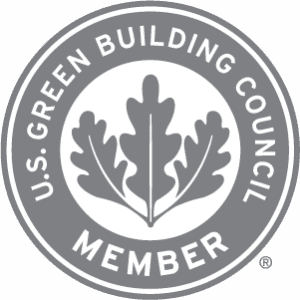

ClearChem Standard
The ClearChem Standard BkA-CC-01 specifically focuses on claims related to the emissions of volatile organic compounds (VOCs) from products that are used to construct and finish buildings interiors. The most cited and used standard for the testing and assessment of products for VOC emissions is CDPH Standard Method V1.2 (supersedes CDPH Standard Method V1.1 and often referred to as California Section 01350). The CDPH Standard is specifically required to qualify products for the Indoor Environmental Quality Low-Emitting Material credit of USGBC’s LEED v4 building rating system.
Numerous AVL products Meet the standard for VOC emissions tested by CDPH Standard Method V1.2 with testing certificates available.

Why AVL Builds Green
The built environment has a profound impact on our natural environment, economy, health and productivity. In the United States, buildings account for:
- 36% of total energy use
- 65% of electricity consumption
- 30% of greenhouse gas emissions
- 30% of raw materials use
- 30% of waste output/136 million tons annually
- 12% of potable water consumption
Breakthroughs in building science, technology and operations are available to designers, builders and owners who want to build “green” and maximize both economic and environmental performance.
Environmental benefits:
- Enhance and protect ecosystems and bio diversity
- Improve air and water quality
- Reduce solid waste
- Conserve natural resources
Economic benefits:
- Reduce operating costs
- Enhance asset value and profits
- Improve employee productivity and satisfaction
- Optimize life-cycle economic performance
Health and community benefits:
- Improve air, thermal and acoustic environments
- Enhance occupant comfort and health
- Minimize strain on local infrastructure
- Contribute to overall quality of life
AVL Systems Inc. USGBC LEED Contribution
The LEED® (Leadership in Energy and Environmental Design) Green Building Rating System created by USGBC, is a voluntary building certification program that defines high-performance green buildings, which are more environmentally responsible, healthier, and more profitable structures. LEED was created to establish a common standard of measurement for what constitutes a “green” building. LEED serves as a design guideline for green building and offers third party validation of a building’s green features. LEED evaluates buildings in five areas: Sustainable Sites, Water Efficiency, Energy & Atmosphere, Materials & Resources and Indoor Environmental Quality. Within these credit areas, points are available and depending on the number of points a project earns determines the level of certification the building will be awarded. There are four progressive levels of certification: Certified, Silver, Gold and Platinum. Developed by the U.S. Green Building Council, LEED addresses a variety of buildings and building project types through individualized systems, including:
- New Construction
- Existing Buildings
- Commercial Interiors
- Core & Shell
Does the LEED Rating System Recommend Building Products?
No, USGBC certifies buildings and tenant spaces under the LEED rating system, not the materials that are used to construct the building.
But within the LEED rating systems, building products contribute to achieving LEED points following performance based requirements. To meet these requirements, practitioners identify products that have attributes that contribute to the project’s aggregate environmental or health value.
AVL Systems’ Products and the LEED Rating System
The LEED Building Rating System was established by the USGBC to evaluate all aspects of design and construction to emphasize
- Energy efficiency
- Conservation
- Overall Health of the Building
As such, the use of environmentally progressive manufactured materials can contribute to the overall rating of the construction project.
As an active Member of the USGBC, AVL Systems’ in-house LEED CI AP (Leadership in Energy & Environmental Design – Commercial Interiors Accredited Professional) assists Project Managers and Professionals to identify and catalogue areas of available credit for AVL Systems Acoustical Products which will contribute to an aggregate score for LEED Certification.
And, as a part of our Total Professional Service, AVL Systems provides this assessment and the necessary Original Manufacturer’s Material Certifications to our Partner/Customers on a per project basis.
